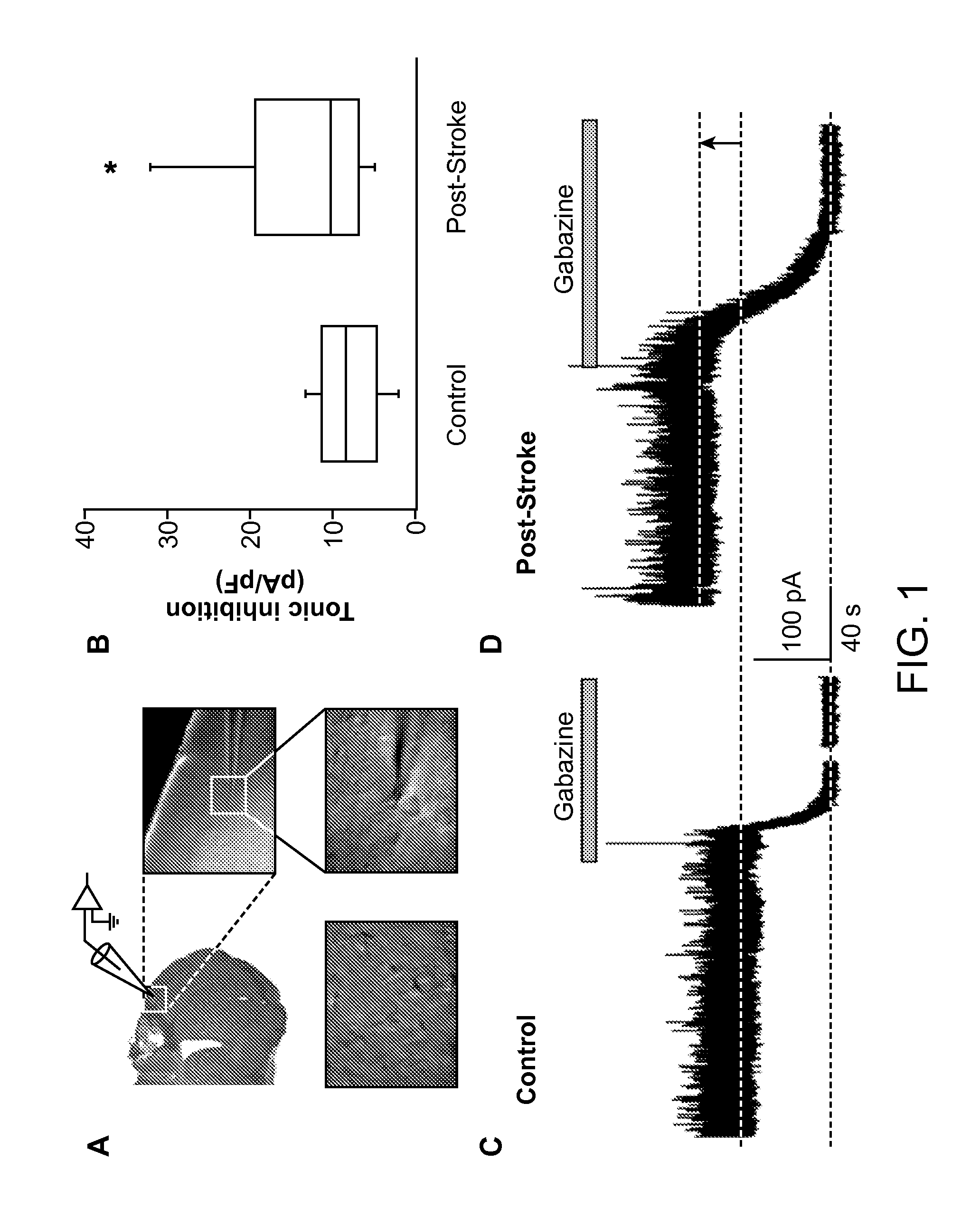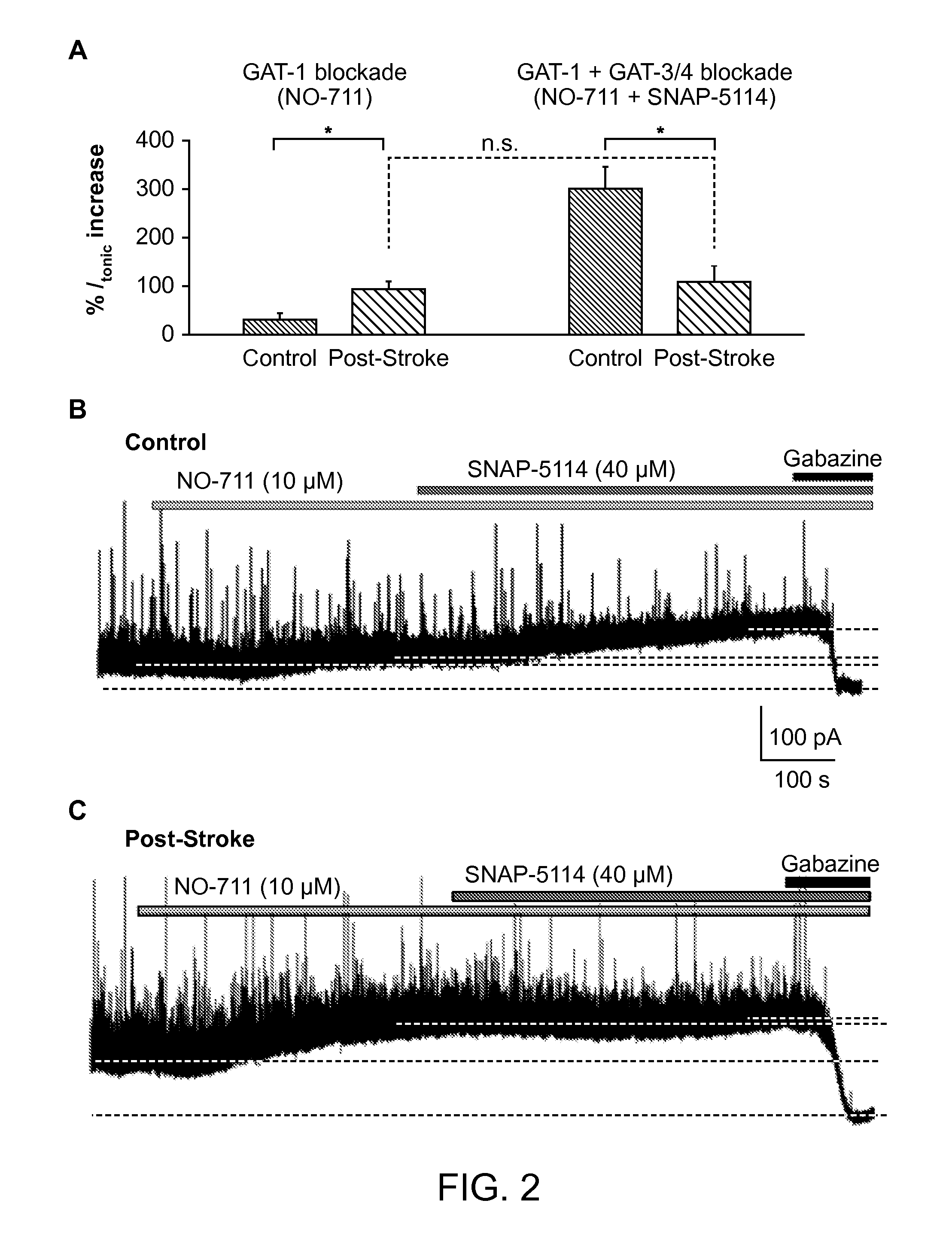Methods and compositions for treating a subject for central nervous system (CNS) injury
a central nervous system and injury technology, applied in the direction of drug compositions, cardiovascular disorders, biocide, etc., can solve the problems of limited recovery, loss of behavioral function, damage to the brain or spinal cord, etc., and achieve the effect of inhibiting the degradation of neural excitability and enhancing the excitability of damaged neurons
- Summary
- Abstract
- Description
- Claims
- Application Information
AI Technical Summary
Benefits of technology
Problems solved by technology
Method used
Image
Examples
example 1
Effect of Stroke on Tonic GABA Signaling
[0624]To test the effect of stroke on tonic GABA signaling, patch clamp studies were performed on neurons in motor cortex adjacent to the stroke site (FIGS. 1A to 1D). This region, known as peri-infarct cortex, is the site of the most significant stroke recovery in humans (Carmichael S T (2006) Cellular and molecular mechanisms of neural repair after stroke: making waves. Annal Neurol. 59:735-742).
[0625]Whole-cell patch-clamp recordings were made from post-stroke brain slices, within 200 μm of infarct (top left), from layer-2 / 3 (top right) pyramidal neurons (bottom panels) (FIG. 1A). Cells were voltage-clamped at +10 mV. Box-plot (boxes: 25-75%, whiskers: 10-90%, lines: median) showed significantly elevated tonic inhibition in peri-infarct cortex (asterisk: PARs with gabazine (>100 μM).
[0626]Whole-cell voltage-clamp recordings in in vitro brain slices prepared at 3-, 7- and 14-days post-stroke showed a significant increase in GABAAR-mediated t...
example 2
Stroke Model
[0630]Stroke completely destroys the tissue in at the center of the stroke (the core) and partially damages the tissue adjacent to the infarct (Katsman D, Spinelli K, Zhang J, and Carmichael S T (2003) Tissue microenvironments within functional cortical subdivisions adjacent to focal stroke. J Cereb Blood Flow Met 23:997-1009; Carmichael S T, Archibeque I, Luke L, Nolan T, Momiy J, Li S. (2005) Growth-Associated Gene Expression after Stroke: Evidence for a growth-promoting region in peri-infarct cortex. Expt Neurol. 193:291-311), i.e., the peri-infarct region. Studies indicate that this peri-infarct region is disabled through partial damage to neuronal circuits, as described above. To model this process experimentally, a stroke model was used that produces complete damage to a part of the brain that controls forelimb use in a mouse, the forelimb motor cortex (FIGS. 5A-5B). FIG. 5A shows a schematic view of the motor control areas in the mouse cortex. The stroke destroys ...
example 3
Effect of GABAaRα5 Inverse Agonist
[0631]To test the role of tonically active GABA receptor signaling in stroke recovery, the GABAaRα5 inverse agonist (L655,708) was administered beginning three days after stroke. This time period was chosen because it is after the period of most cell death in this stroke model (Braun J S, Jander S, Schroeter M, Witte O W, Stoll G (1996) Spatiotemporal relationship of apoptotic cell death to lymphomonocytic infiltration in photochemically induced focal ischemia of the rat cerebral cortex. Acta Neuropathol. 92:255-63) and represents a high-value translational target for human stroke therapies. Treatments that must be administered very early in the clinical course of stroke, such as tPA, are difficult to deliver because most patients are not in the hospital and so rapid emergency response and laboratory screening systems must be developed. In contrast, drugs that are truly acting as a neural repair therapy may be delivered at later time points when mos...
PUM
| Property | Measurement | Unit |
|---|---|---|
| time | aaaaa | aaaaa |
| pharmaceutical composition | aaaaa | aaaaa |
| morphologic plasticity | aaaaa | aaaaa |
Abstract
Description
Claims
Application Information
 Login to View More
Login to View More - R&D
- Intellectual Property
- Life Sciences
- Materials
- Tech Scout
- Unparalleled Data Quality
- Higher Quality Content
- 60% Fewer Hallucinations
Browse by: Latest US Patents, China's latest patents, Technical Efficacy Thesaurus, Application Domain, Technology Topic, Popular Technical Reports.
© 2025 PatSnap. All rights reserved.Legal|Privacy policy|Modern Slavery Act Transparency Statement|Sitemap|About US| Contact US: help@patsnap.com



